With my last post, I thought I’d touch on a minor concern among journalism professionals: The future.
Specifically I want to consider the future of newspapers, especially local ones like the Tuscaloosa News.
I pulled these nationwide newspaper stats from an article on the Business Insider, “The year newspapers died.” These are solely from the first half of 2009 (a rough year of closures):
—105 newspapers have been shuttered.
—10,000 newspaper jobs have been lost.
—Print ad sales fell 30% in Q1 ’09.
—23 of the top 25 newspapers reported circulation declines between 7% and 20%
The numbers are scary. How can we not expect all newspapers to be gone in five to ten years? Readers are getting their content elsewhere and for free, and incidentally the advertisers are going with them. And as publications struggle to meet the necessary financial needs, it seems like the small, local newspapers are the most vulnerable.
Yet as destructive as evolving technologies have been to print journalism, I believe they also hold the answer to the future. How well can a newspaper adapt? That, my friend, is the million-dollar question and the key to survival.
The services of a local organization, such as the Tuscaloosa News, will always be needed. No other national publication can serve the public like a local newspaper, which listens to what the community cares about, raises important local issues, and covers neighborhood events. A national publication may report on breaking news, but a local newspaper tells how that news impacts the lives of its residents.
Therefore, as long as local publications can adapt to a new business model, there’s hope. This includes addressing dilemmas such as figuring out how to provide the same accuracy and immediacy with fewer reporters, finding new ways to advertise and charge for content, and being flexible and creative in the ways they provide their content.
After talking with Lydia and a couple other reporters, I think the Tuscaloosa News is right on track. As evidence of Lydia’s evolving duties, they’re adapting to budding technologies without sacrificing the quality of their service to the community.
As a student, I think it’s important to look at all the changes within the profession and determine how I can better prepare myself for a journalism career. The ability to work with new technologies (video editing, graphic design, etc.) is no longer merely helpful, but necessary. It’s never been more important to stay informed about economics and government. Good writing, as always, never comes without experience and hard work. And the ability to be innovative—applying the basic principles and responsibilities of journalism to an ever-changing world—seems as if it will be the determinant my success.
Look out, world, here I come! (That is, after I gain about 45 more credit hours…)
